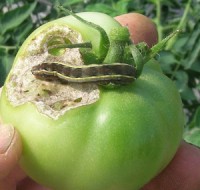Insects and Related Pests of Tomatoes
go.ncsu.edu/readext?187048
en Español / em Português
El inglés es el idioma de control de esta página. En la medida en que haya algún conflicto entre la traducción al inglés y la traducción, el inglés prevalece.
Al hacer clic en el enlace de traducción se activa un servicio de traducción gratuito para convertir la página al español. Al igual que con cualquier traducción por Internet, la conversión no es sensible al contexto y puede que no traduzca el texto en su significado original. NC State Extension no garantiza la exactitud del texto traducido. Por favor, tenga en cuenta que algunas aplicaciones y/o servicios pueden no funcionar como se espera cuando se traducen.
Português
Inglês é o idioma de controle desta página. Na medida que haja algum conflito entre o texto original em Inglês e a tradução, o Inglês prevalece.
Ao clicar no link de tradução, um serviço gratuito de tradução será ativado para converter a página para o Português. Como em qualquer tradução pela internet, a conversão não é sensivel ao contexto e pode não ocorrer a tradução para o significado orginal. O serviço de Extensão da Carolina do Norte (NC State Extension) não garante a exatidão do texto traduzido. Por favor, observe que algumas funções ou serviços podem não funcionar como esperado após a tradução.
English
English is the controlling language of this page. To the extent there is any conflict between the English text and the translation, English controls.
Clicking on the translation link activates a free translation service to convert the page to Spanish. As with any Internet translation, the conversion is not context-sensitive and may not translate the text to its original meaning. NC State Extension does not guarantee the accuracy of the translated text. Please note that some applications and/or services may not function as expected when translated.
Collapse ▲NC State University developed a series of documents that discuss a variety of common insects and related pests of tomatoes. They address the name, physical description, and biology of the pests, as well as recommendations for controlling populations and plant damage.
- Greenhouse Whitefly
- Hornworms
- Tomato Cutworms
- Tomato Fruitworms
- Tomato Pinworms
- Silverleaf Whitefly
- Vegetable Leafminer
- Western Flower Thrips
Nematode Management in Tomatoes, Peppers, and Eggplant
This comprehensive guide introduces plant-parasitic nematodes and discusses crop production problems, symptoms and control measures associated with nematodes. This resource was developed by the University of Florida and sometimes uses Florida-based data and examples. The lessons and concepts explored, however, can be applied to growers in North Carolina and the Southeast.
Also, see the Control of Root-Knot Nematodes in the Home Vegetable Garden.
Greenhouse Tomato Insect Management
Greenhouse Insect Management
The warm, humid conditions and abundant food in a greenhouse provide an excellent, stable environment for pest development. Often, the natural enemies that serve to keep pests under control outside are not present in the greenhouse.
Insect and Mite Management in Greenhouses
The objective of this University of Tennessee publication is to assist greenhouse tomato producers in implementing a pest management program, starting with the basics.
Reviewed and updated 10/3/2022.
| < < < Weeds | Diseases > > > |



